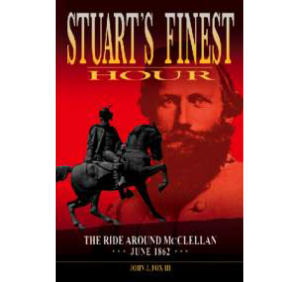 Stuart’s Finest Hour: The Ride Around McClellan, June 1862 is ready as an E-Book at KINDLE and NOOK. Stuart’s Finest Hour is also available on I-TUNES. The Confederate Alamo: Bloodbath at Petersburg’s Ft. Gregg is available in KINDLE and NOOK. Many thanks to Savas Beatie Historical Publishers for their help making these award-winning books possible!
Stuart’s Finest Hour: The Ride Around McClellan, June 1862 is ready as an E-Book at KINDLE and NOOK. Stuart’s Finest Hour is also available on I-TUNES. The Confederate Alamo: Bloodbath at Petersburg’s Ft. Gregg is available in KINDLE and NOOK. Many thanks to Savas Beatie Historical Publishers for their help making these award-winning books possible! 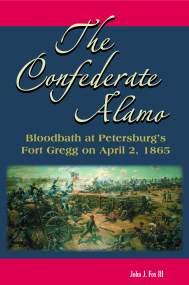
Two Angle Valley Press Titles Available as E-Books
Angle Valley Press 10th Anniversary & Father’s Day Sale – Huge Civil War Book Discounts!
Celebrate the 10th anniversary of Angle Valley Press together with the upcoming Father’s Day. We are steeply discounting almost all of our Civil War books until midnight on Sunday June 22. We want to thank all of our customers for your support since 2004! CLICK ABOVE ON “OUR BOOKS” ICON to see the SPECIALS.
Stuart’s Finest Hour Receives IPPY Book Award
Winchester Author Receives Award for Civil War Book
By Nancy Jones, Angle Valley Press, LLC
FOR IMMEDIATE RELEASE
John J. Fox’s Stuart’s Finest Hour: The Ride Around McClellan, June 1862 awarded a 2014 IPPY Bronze Medal for Mid-Atlantic’s Best Regional Non-Fiction category.
“Utilizing previously unseen primary sources, he has created a deeply researched and smooth-reading narrative that has the sounds of bugles, saber strikes, and thundering hoofs resonating from its pages.” ~ Paul Taylor, Civil War News, January 2014
Winchester, VA., May 27, 2014 – The Independent Publisher Book Awards are conducted annually and honor this year’s best independently published titles from all over the world. The 2014 IPPYS will highlight the best regional titles from North America and Australia/New Zealand.The official 2014 IPPY medal ceremony will take place on May 28 in New York City, one day before the opening of the BookExpo America Conference.
John Fox’s award-winning title is the first book ever written about the dramatic Great Chickahominy Raid that  made Confederate cavalry General Jeb Stuart famous. Stuart led 1,200 horsemen on a dangerous three-day reconnaissance mission deep behind Union lines east of Richmond, Virginia in mid-June 1862. The information that Stuart carried back to Richmond gave General Robert E. Lee the confidence to attack the right flank of General George McClellan’s Federal army. The tactical and strategic impact of Stuart’s raid allowed the subsequent Confederate offensive, known as the Seven Days’ Battles, to push the numerically superior Union army away from Richmond. The war lasted almost three more bloody years before Federal troops would have another similar opportunity to capture Richmond.
made Confederate cavalry General Jeb Stuart famous. Stuart led 1,200 horsemen on a dangerous three-day reconnaissance mission deep behind Union lines east of Richmond, Virginia in mid-June 1862. The information that Stuart carried back to Richmond gave General Robert E. Lee the confidence to attack the right flank of General George McClellan’s Federal army. The tactical and strategic impact of Stuart’s raid allowed the subsequent Confederate offensive, known as the Seven Days’ Battles, to push the numerically superior Union army away from Richmond. The war lasted almost three more bloody years before Federal troops would have another similar opportunity to capture Richmond.
Savas Beatie LLC is a leading independent military and general history publishing companythat markets Angle Valley Press titles to museum and park bookstores throughout the country. Their managing director, Theodore P. Savas, noted, “We are pleased this award went to John Fox and Angle Valley Press. He is one of the finest researchers and writers working today in Civil War history, and this award proves it. Stuart’s Finest Hour is an example of his dedication to first class history.”

Angle Valley Press LLC is a Winchester-based history book publisher in business since 2004.
John J. Fox is an award-winning Civil War historian who lives in Winchester, Virginia. He is the author or editor of several books and articles about the Civil War including Red Clay to Richmond [2004] and The Confederate Alamo [2010].
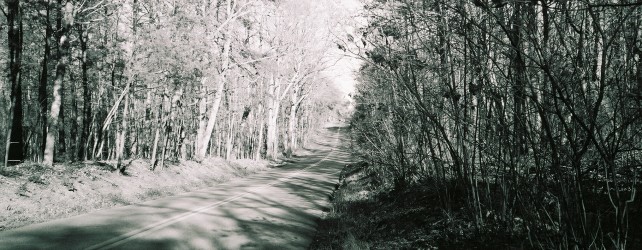
Confederate Roar at Wilderness on Night of May 7, 1864
A battlefield roar that invigorated the Confederates echoed along their line in the middle of the Wilderness on the evening of May 7. Most of George Meade’s Army of the Potomac and Robert E. Lee’s Army of Northern Virginia faced each other behind defense lines deep in the tangled gnarl of the Wilderness woods. Two previous days of grisly fighting had decimated the ranks of both sides and now each commander tried to assess the others intentions.
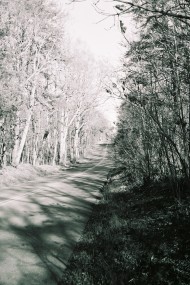
Battle of Wilderness – Orange Plank Road looking east toward Federal Position near Brock Road intersection. Notice density of brush and this photo taken in winter w/out foliage. This image is actual site where Edward Thomas’ Georgia Brigade manned the line early on May 6, 1864
The defense lines stretched from Orange Turnpike south beyond Orange Plank Road as “the brush fires continued to try to cleanse the battleground of its grisly sites. The acrid smell of wood smoke filled the air. This smoke frequently blotted out sunlight. That night, a spontaneous unforgettable vocal display occurred in the woods of the Wilderness. Far to the south at the right end of Lee’s line a distant noise broke the night air. All along the line men paused to determine its source. The sound soon grew louder. The noise was the shouts of Confederate soldiers. More men joined the roar as it rolled from regiment to regiment along the line from right to left. The sound echoed northward until it reached the far end of Ewell’s corps.”
“Again the shout arose on the right – again it rushed down upon us from a distance of perhaps two miles – again we caught it and flung it joyously to the left, where it only ceased when the last post had huzzahed. And yet a third time this mighty wave of sound rang along the Confederate lines. The effect was beyond expression. It seemed to fill every heart with new life, to inspire every nerve with might never known before. Men seemed fairly convulsed with the fierce enthusiasm; and I believe that if at that instant the advance of the whole army upon Grant could have been ordered, we would have swept it into the very Rappahannock.”
The armies next tangled at a place called Spotsylvania Court Houseagain – 150 years ago from right now.
Footnotes: 2nd paragraph from John J. Fox III, Red Clay to Richmond: Trail of the 35th Georgia. (Winchester, 2004. Angle Valley Press, p. 254-256.
3rd paragraph originally found in – J.F.J. Caldwell, The History of a Brigade of South Carolinians Known As ‘Gregg’s’, and Subsequently As ‘McGowan’s’ Brigade. (Philadelphia, 1866) (Morningside Press reprint 1992, Dayton, Oh. , p.184).
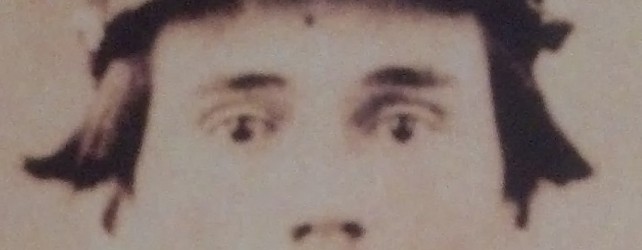
Who is the 35th Georgian on the cover of Red Clay to Richmond?
Ever since Red Clay to Richmond was released ten years ago, I have been asked many times about the 35th Georgia soldier on the cover. Well, that serious face with haunting eyes belonged to Private John Rigby from Company D, 35th Georgia. Before he enlisted in 1861, he was a sharecropper in Hogansville, Georgia. The bowie knife in the left hand and the bayonet-tipped rifle in the right seemed to foreshadow the tough battlefields he would soon cross as the image was probably taken in Richmond in early spring 1862 before he and his fellow Georgians had officially seen “the elephant” in a full-scale fight.
Rigby would be wounded on June 26, 1862 at the Battle of Mechanicsville at the beginning of the Seven Days’ Battles. Hit in the right thigh and left chest, he suffered a collapsed lung. Once his condition stabilized doctors sent him to convalesce at home in Troup County. While there his wife, Nancy, nursed him back to health and her heart must have broken again when he left in December to return to the fighting in Virginia. When they parted she would never see her husband again. 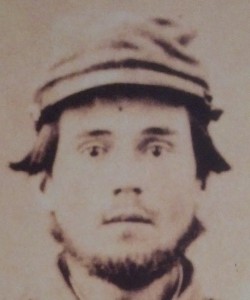
John somehow survived unscathed the heavy fighting of 1863 at Chancellorsville and Gettysburg. He no doubt longed for a furlough back to Georgia, but by the winter of 1863-1864 the manpower shortage in the Army of Northern Virginia had reached epic numbers especially with James Longstreet’s corps detached to reinforce Braxton Bragg’s army in Georgia and Tennessee.
March 1864 found Edward Thomas’ Georgia Brigade [14th, 45th, 49th and 35th Georgia regiments] back in winter camp near Orange Court House with the rest of Robert E. Lee’s army. The Georgians had spent the previous three months in the Shenandoah Valley marching and countermarching in bitter cold trying to drive various Federal units away.
Then on May 2, “as if to foreshadow the coming violence of battle a horrendous thunderstorm passed over the Orange Court House area” flattening tents and scattering equipment. Two days later, numerous 35th Georgians attended a prayer meeting, but a courier soon arrived “with orders for the men to strike tents and to cook two days’ rations.” The Georgians departed camp that night around 10 pm. The column passed through Orange CH and then “turned east onto the Orange Plank Road toward Fredericksburg.” The Overland Campaign had begun.
What these Confederates didn’t know was that the Army of the Potomac was on the move from their winter camps around Culpeper. It would be a race to see if the Rebels could move far enough east to block the long blue columns moving across the Rapidan River toward the important crossroads where Wilderness Tavern stood.
Both armies banged into each other on May 5. As the sun began to set, Thomas’ men moved into the murky woods north of the Orange Plank Road and about a half-mile north of the Widow Tapp Farm. The Georgians soon found themselves fighting from three sides due to an attack by four brigades led by James Wadsworth out of the Union Fifth Corps. When all hope seemed lost, a rebel yell suddenly pierced the woods and “a thin line of 5th Alabama Battalion men, scrounged from a prisoner detail, swept onto the scene. They miraculously pushed back Wadworth’s first line. By the time the Union officers restored order to their ranks, it was dark” and another attack could not be mounted in the thick woods of the Wilderness.
Later that night, Thomas’ Georgians quietly pulled out of the area and moved to a position across the Orange Plank Road and just west of the Brock Road intersection. The fighting resumed at daylight on May 6. A strong Union infantry attack led by Winfield Hancock’s Second Corps pushed back the Confederate brigade on the Georgians right flank. Smoke from gunpowder and burning brush floated just above the ground. Then bullets zipped by from three sides again and Southern casualties mounted. Thomas’ panicked men began a chaotic withdrawal by their left flank.
Something struck John Rigby and he fell down as his colleagues swarmed toward the rear. The approaching line of blue-clad infantry soon gathered up Rigby and nearly fifty more 35th Georgians, most of them wounded. These unfortunate men soon found themselves at the notorious Union prison camp at Elmira, New York. Called “Hellmira” by most of the inhabitants, it became “infamous for having the highest prisoner mortality rate of any Northern prison camp.” At least ten of the captured 35th Georgians from the Wilderness fight would not walk out of Elmira alive.
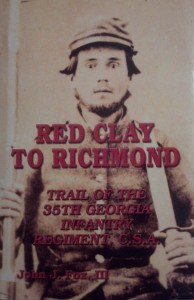
Red Clay to Richmond:Trail of the 35th Georgia Infantry Regiment by John J. Fox III copyright 2004 Angle Valley Press
This sad list included John Rigby. He died of acute bronchitis on May 4, 1865 nearly a month after the surrender at Appomattox. He is buried at Elmira’s Woodlawn National Cemetery in grave #2756.
Nancy Rigby never learned the fate of her husband – whether he was killed on the battlefield or captured. Forever holding out hope that he would come home she “refused to apply for a government veteran’s pension until 1893.” When she died in 1897 her family buried her at Liberty Cemetery in Bremen, Georgia. Next to her grave stood an empty spot for John.
All of the above information came out of Red Clay to Richmond to Richmond: Trail of the 35th Georgia published by Angle Valley Press [2004]. I would like to again thank the Pollard and Mullinax families for giving me so much information on their great-great grandfather, John Rigby, and for allowing me to use his image on the cover of the book.

